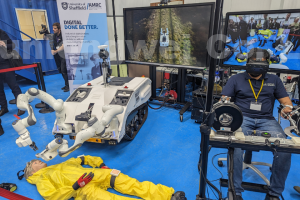
It had made £1.3 million available for “telexistence” innovations as part of a competition for commercial proposals, launched in January 2022.
The three projects that had been selected from Phase 1 were MediTel (involving the University of Sheffield AMRC and Sheffield Robotics), TEL MED and TEL ND (Bettering Our Worlds, formerly Cyberselves), and TNO (TNO, SenseGlove and University of Twente). These have now come to fruition – the Phase 2 demonstration event was held at the BattleLab, one of the Ministry of Defence’s innovation acceleration facilities.
DASA had sought innovations to develop a complete telexistence system, integrating telepresence, robotic and haptic technologies on to a single platform. This would help those working in hazardous environments – to give them the capability to undertake tasks without being physically present. Basically, to reduce the risk to personnel and also increase the efficiency of operations.
For example, MediTel (pictured above) were funded to develop a complete telexistence system for medical care on the battlefield. Its system comprises a robotically-controlled tracked Uncrewed Ground Vehicle (UGV), which features two tool boxes and two robotic arms. These are able to grasp and effectively operate tools, such as blood pressure cuffs, auto-injectors and thermometers.
It has two modes, a driving mode and triage mode and is controlled during both modes by a pair of haptic devices which transmit sensory information from the remote environment to the person operating the device.
Telexistence technologies
“We are using innovation and technology to overcome the challenges of identifying and removing nuclear waste from our sites, so we can store it safely and eventually permanently dispose of it,” said Andrew Gray, the Nuclear Decommissioning Authority’s Innovation Delivery Manager.
“It’s our aim to reduce decommissioning activities carried out by humans in hazardous environments by 50% by 2030. This collaboration could revolutionise our ability to access contaminated areas, which are unsafe or impossible for humans to enter.”
Areas of interest for the telexistence technologies include nuclear decommissioning, and the “defence and security communities”.
You can read more about Phase 2 of the programme here.
See also: DASA funding seeks to support telexistence tech
View more : IGBT modules | LCD displays | Electronic Components